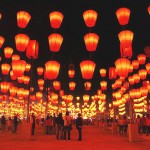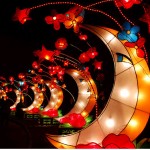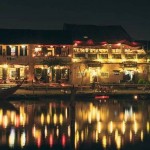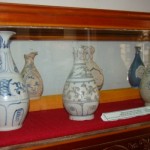Tet, also called Tet Nguyen Dan, is one of the most celebrated Vietnam festivals & events. The Vietnamese, wherever they may be, are all thrilled and excited with the advent of Tet, and they feel an immense nostalgia, wishing to come back to their homeland and a taste of the particular flavours of the Vietnamese festivities.
Tet holiday starts on the first day of the first lunar month and is the first season of the new year (according to the lunar calendar), therefore, it is also known as the Tet Nguyen Dan, literally meaning Fete of the First Day. It is the time for family reunions, commemoration of ancestors, harmony and exchange of best wishes, special food, new clothes, new beginnings and other festive activities. For the Vietnamese people, Tet is like a combination of Western Saint Sylvester, New Year’s Day, Christmas, Easter and Thanksgiving. It is the festival of Purity and Renewal.
The Vietnamese people begin their preparations for the New Year well in advance of the Tet. In order to get rid of the bad fortune, if any, associated with the old year the Vietnamese people clean their homes, utensils and sometime paint their homes as well. They buy new clothes and shoes, pay their pending debts and resolve the differences between families and friends.
Like the Chinese the Vietnamese people also believe that the events and works that they do on the evening of Tet determines their luck for the rest of the year. Hence everything that they do on this day should symbolize good fortune. The Kitchen God Tao is paid homage on this day as they believe that the three legs of the traditional cooking equipment in the kitchen represent three gods. Besides, gifts are also exchanged between family members and friends and relatives are visited during this period.
The special festive food during the Tet, is rice pudding or Banh Chung. Along with this there are preserved sweets, beef, chicken, fish and fruits especially watermelons because of their red color which is considered lucky. The Vietnamese families’ plant a bamboo tree called Cay Neu in their courtyard during the Tet. This is decorated with bells, flowers and red streamers to guard them against bad luck and let good fortune flow into their homes all year through.
Prepare to be amazed by the magnificent lion and dragon dancers, traditional ceremonies, tradional dress shows, famous singers and entertainers, sport tournaments, and much much more. Tet will definitely take the visitors to a fascinating and cultural escapade, exploring the deep meaning of the Tet festival and its customs.
Learn more Vietnamese New Year Customs….
LE TAO QUAN
During the week before Tet, fresh earth is placed on top, weeds removed from around it and incense is burnt to invoke the souls of the dead from the other world to return to visit the family home. The Kitchen God (Ong Tao or Mandarin Tao) is also called the Hearth God, the Stove God or the Household God. This God, who was privy to the family’s most private business and intimate secrets for the ending year, returns to Heaven to make his report to the Jade Emperor. This report includes the year’s activities of the household in which he has lived. On the 23rd day of the 12th month, the household offers the Kitchen God a farewell and thank you dinner. The Kitchen God will need a week for his mission to Heaven.
Clean and decorate the home
Homes are often cleaned and decorated before New Year’s Eve. Children are in charge of sweeping and scrubbing the floor. The kitchen needs to be cleaned before the 23rd night of the last month. Usually, the head of the household cleans the dust and ashes (from incense) from the ancestral altars. It is a common belief that cleaning the house will get rid of the bad fortunes associated with the old year. Some people even paint their houses and decorate them with festive items.
The general atmosphere leading up to Tết is in the bustle of shopping, decorating the home with “cau doi”, “sentence in pair”, flowers, cooking traditional Tết food and waiting for tet7relatives to return home. People try to pay off their debts in advance so that they can be debt-free on Tết. Parents buy new clothes for their children so that the children can wear them when Tết arrives. Because a lot of commercial activity ceases during the celebrations, people try to stock up on supplies as much as possible. In the days leading up to Tết, the streets and markets are full of people, and everyone is busy buying food, clothes, and decorations for their houses.
Vietnamese families usually have a family altar, used to pay respect to their ancestors. On the altar they have a tray of five fruits called “Ngũ Quả”, including custard apple, coconut, papaya, and mango. They sound like “cầu vừa đủ xài” (“We pray for enough money to spend”), and each fruit conveys a different meaning. During Tết, the altar is thoroughly cleaned and ornated with new offerings.
In the days leading up to Tết, each family cooks special holiday foods such as “bánh chưng” and “bánh dầy”. Preparations for these foods are quite extensive. As usual, the work is performed by the women of the household. Sticky rice, which is made from glutinous rice and is known in Viet Nam as pearl rice, is first soaked in water for eight hours, washed and tet9dried. The green beans are hulled, then cooked and pressed into small balls. The fresh “dong” leaves, which come from forested areas, also have to be wiped and dried. Five or six “dong” leaves are used to line a square wooden box. Rice is then spread out over the leaves before a layer of green beans. Next comes a strip of pork, then a layer of green beans, and finally the sticky rice. The whole thing is bundled up and boiled for 10 hours. Family members often take turns to keep watch on the fire overnight, telling each other past-years stories about Tết. Although the onrush of modern society means less people are preparing their own “Banh Chung”, those that still do the work can rest assured they are bringing together the essence of Heaven and Earth.
New Year’s Eve
The transition hour between the old year and the new year means “Passage from the Old to the New Year”. It is one of the most important times during the TET holidays. It occurs at midnight on New Year’s Eve. “Giao Thua” is also the time for Ong Tao (Kitchen God) to return to earth after making the report to the Jade Emperor. Every single family should offer an open-air ceremony to welcome him back to their kitchen.
The Aura of the Earth
Since the Vietnamese believe that the first visitor a family receives in the year determines their fortune for the entire year, people never enter any house on the first day without being invited first. The act of being the first person to enter a house on Tết is called “xông đất, xông nhà or đạp đất” – “The aura of the Earth”, and it is one of the most important rituals during Tết. If that particular guest has a good aura (well respected, well educated, successful, famous, etc.), then the family believes that it will receive good luck and fortune tet10throughout the year. The belief of “xong dat” is still present nowadays, especially among families with businesses. Sometimes, just to be safe, the owner of the house will leave the house a few minutes before midnight and come back just as the clock strikes midnight, in order to prevent anyone else from entering the house first, as that person could potentially bring unfortunate events to the household in the new year.
The first day of Tết is reserved for the close family. The holiday is also observed by a family visit to the church or pagoda to pray for good fortune and happiness. On these days, Vietnamese visit their relatives and temples, forgetting about the troubles of the past year and hoping for a better upcoming year.
Apricot flowers and peach flowers
Flower buds and blossoms are the symbols for new beginnings. These two distinctive flowers are widely sold and purchased during Tet. Flower buds are the yellow apricot flowers often seen in Southern Viet Nam; they are more adaptable to the hot weather in the Southern regions, and are thus known as the primary flowers in every home. The flower blossoms, with the warm pink of the peach blossoms, match well with the dry, cold weather in the North. Tet is not Tet if there is no sight of flower buds (south) or flower blossoms (north) in every home.
Offering of red envelopes (filled with lucky money)
This is a cultural practice that has been maintained for generations. The red envelopes symbolize luck and wealth. It is very common to see older people giving sealed red envelopes to younger people. Also, the older ones offer good advice and words of wisdom, encouraging the younger ones to keep up with the schoolwork, live harmoniously with others, and obey their parents.
This greeting ritual and Li Xi is also known as “Mung Tuoi”, honoring the achievement of another year to one’s life.
Making offers to the Ancestors
This ceremony is held on the first day of the New Year, before noontime. The head of the household should perform the proper ritual (offering food, wine, cakes, fruits, and burn incense) to invite the souls of the ancestors to join the celebration with the family. This is the time families honor the souls of their ancestors, and present the welfare of the family.
Vietnamese New Year Foods
One of the most traditional special foods for New Years (Tet) is Banh Chung or sticky rice cake. Banh Chung is made of sticky rice, pork meat and green bean, every ingredient is wrapper inside a special leaf which calls Dong. Making the Banh Chung requires care and precision in every step. The rice and green bean has to be soaked in water for a day to make it stickier. The pork meat is usually soaked with pepper for several hours. Squaring off and tying the cakes with bamboo strings require skillful hands to make it a perfect square.
Soure: hoian-tourism.com
Post Views:
2,090














